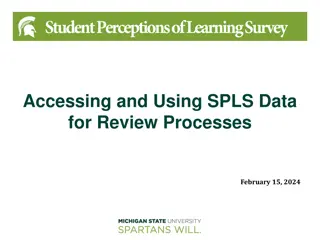
Analytical Chemistry Experiment: Determination of Acetyl Salicylic Acid by UV Spectrophotometry
Explore the analysis of acetyl salicylic acid (aspirin) through UV spectrophotometry, including its synthesis, properties, and importance. Understand the methodology based on converting aspirin to salicylic acid for accurate measurement. Delve into the principles of absorption spectroscopy and the UV region for organic compounds.
Download Presentation

Please find below an Image/Link to download the presentation.
The content on the website is provided AS IS for your information and personal use only. It may not be sold, licensed, or shared on other websites without obtaining consent from the author. If you encounter any issues during the download, it is possible that the publisher has removed the file from their server.
You are allowed to download the files provided on this website for personal or commercial use, subject to the condition that they are used lawfully. All files are the property of their respective owners.
The content on the website is provided AS IS for your information and personal use only. It may not be sold, licensed, or shared on other websites without obtaining consent from the author.
E N D
Presentation Transcript
01 Practical Analytical Chemistry Instrumental Analysis 02 03 04 4th Stage - Biomedical Science 05 06 Assist. Prof. Dr. Hijran S. Jabbar MSc. Sara H. Assaf MSc. Nigar A. Omar 07 2023 - 2024 08 09 10
01 Experiment No. (1) Determination of acetyl salicylic acid by ultraviolet spectrophotometry 02 03 This method is based on analysis of A.S.A (aspirin ) in the presence of base NaOH into pure salicylic acid ( indirect method ) in max ( 292 nm) 04 05 06 07 08 09 10
01 Experiment No. (1) Determination of acetyl salicylic acid by ultraviolet spectrophotometry 02 03 Aspirin is synthesized by reaction of Salicylic acid and acetic anhydride in an acidic medium 04 05 06 07 08 09 10
01 Experiment No. (1) Determination of acetyl salicylic acid by ultraviolet spectrophotometry 02 03 salicylic acid is a white crystalline compound, which can be isolated from the bark of birch trees. Since it is a valuable substance that can be isolated from nature . It is called a useful ( natural product ). 04 05 06 Acetyl salicylic acid ( an ester derivative ) is much more commonly used than salicylic acid, because the parent compound can be rather irritating to your stomach linings. 07 08 09 10
01 Experiment No. (1) Determination of acetyl salicylic acid by ultraviolet spectrophotometry 02 03 Acetyl salicylic acid commonly known as ( aspirin) is: 04 1. 2. 3. Powerful analgesic Antipyretic Anti-inflammator. 05 06 Note: A.S.A can not tacked directly and draw the calibration curve for it ; because of the molar absorptivity is very small. There for A.S.A converted to S.A that have a high . (indirect (indirect method method ) ).. 07 08 09 10
01 Experiment No. (1) Determination of acetyl salicylic acid by ultraviolet spectrophotometry 02 03 (U.V) region: ( 200 400 ) nm. (n * and * Transitions) 04 Most absorption spectroscopy of organic compounds is based on transitions of n or electrons to the excited state. This is because the absorption peaks for these transitions fall in an experimentally convenient region of the spectrum (200 - 700 nm). These transitions need an unsaturated group in the molecule to provide the electrons. 05 06 07 Molar absorbtivities from n * transitions are relatively low, and range from 10 to 100 L mol-I cm-I * transitions normally give molar absorbtivities between 1000 and 10,000 L mol-I cm-I 08 09 10
01 Experiment No. (1) Determination of acetyl salicylic acid by ultraviolet spectrophotometry 02 03 04 05 06 07 08 09 10
01 Experiment No. (1) Determination of acetyl salicylic acid by ultraviolet spectrophotometry 02 03 04 05 06 07 08 09 10
01 Experiment No. (1) Determination of acetyl salicylic acid by ultraviolet spectrophotometry 02 03 Procedure 04 1. 1 .weigh ( 0.05 gm) of acetyl salicylic acid pure and dissolve in the ( D.W) then transfer it into volumetric flask ( 100 ml) dilute it to the mark. 05 06 2. Pipette ( 1 , 2 , 4 , 6 , 8 , 10 ml ) from the first solution in to 25 ml volumetric flask then add ( 1 ml) of ( 0.1 M) NaOH to each solution then dilute to the mark with ( D.W) Find the conc. of salicylic acid in each volumetric flask. 07 3. Record the absorbance of the other solution at max (292 nm).Using water as blank , and for the unknown. 08 09 10
01 Experiment No. (1) Determination of acetyl salicylic acid by ultraviolet spectrophotometry 02 03 4. Crush one tablet of aspirin in mortar until it become very line. Weigh (0.01 gm) from (A.S.A) and add (20 ml) of (0.1 M) NaOH then filter the solution to separate the ppt. compound from the solution . Transfer the solution to volumetric flask ( 100 ml) and complete the volume to the mark by NaOH solution .Stir the solution for (2 min). Record the absorbance at ( 292 nm). prepare the unknown (aspirin) 04 05 06 07 08 09 10
01 02 03 Any THANK YOU comments? 04 questions or 05 06 07 08 09 10






















